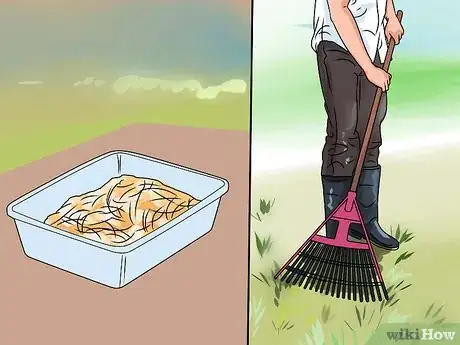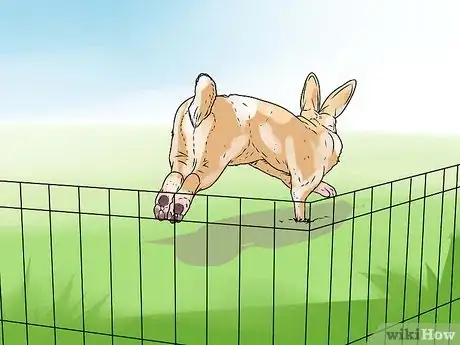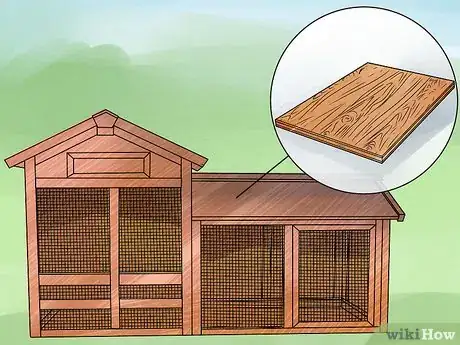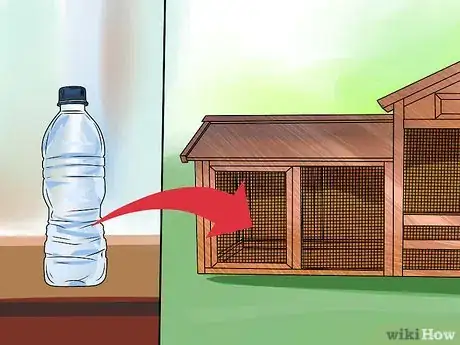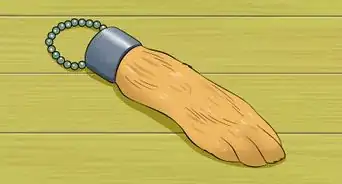This article was co-authored by Pippa Elliott, MRCVS. Dr. Elliott, BVMS, MRCVS is a veterinarian with over 30 years of experience in veterinary surgery and companion animal practice. She graduated from the University of Glasgow in 1987 with a degree in veterinary medicine and surgery. She has worked at the same animal clinic in her hometown for over 20 years.
wikiHow marks an article as reader-approved once it receives enough positive feedback. This article received 24 testimonials and 93% of readers who voted found it helpful, earning it our reader-approved status.
This article has been viewed 296,742 times.
If you choose to keep a pet rabbit outdoors either all or part of the time, proper precautions need to be taken to keep your bunny happy and healthy. Domesticated rabbits need an outdoor home that is spacious, secure, clean, dry, not too hot or cold, well-stocked with food and water, and not isolated from regular contact with humans and any rabbit friends. Help your furry friend live a life that is long enough and enjoyable enough to hop about!
Steps
Practicing Proper Rabbit Care
-
1Decide if your rabbit should stay outdoors at all. Traditionally, pet rabbits have often been kept outside in a pen or “hutch.” And, since you see wild bunnies hopping around all the time, you may assume that your pet will do fine outside as well. But there are many factors to consider.
- Some organizations now strongly urge that you keep house rabbits indoors at all times. Domesticated rabbits have lost the instincts and skills that keep their wild companions alive, and are not creatures that are suited for extreme conditions, or surprises (from predators or otherwise).
- Others contend that it is acceptable to keep rabbits outside during the daytime, when the risk of predators is lower. Even a secure enclosure may not keep your bunny safe from a raccoon, fox, or neighborhood cat.[1]
- Still others still say that, with proper preparation and care, full-time outdoor living is fine. As your rabbit’s caretaker, the decision is yours.
-
2Feed your rabbit more than carrots. Bugs Bunny may have done fine with a single-veggie diet, but real rabbits require lots of hay and diet diversity.
- The staple of your rabbit’s diet should be hay, which should be available at your pet supply store. This should make up about 75% of its diet. They should have hay access at all times. [2]
- Pelleted food should also be a part of your rabbit's diet. Your rabbit should get 1 ounce of hay-based feed per 1 pound of their body weight once a day.
- Each day, you can add leafy greens as a treat and a handful of rabbit pellets, which offer important nutrients.
Advertisement -
3Keep its home clean. A rabbit will typically establish 1 or 2 litter areas in its enclosure (let the rabbit decide where, and then place a bunny litter box there), but keeping the area clean in general is important for health and happiness.
- Do some general clean-up daily, removing soiled straw, etc. Perform a more thorough cleaning at least every 1 to 2 weeks, removing and replacing bedding materials and the like.[3]
- Soiled and/or damp bedding will encourage flies, which can bring on maggots that can infest your rabbit and cause “fly strike,” a potentially fatal illness.[4]
-
4Some rabbits do better in pairs. Wild rabbits are sociable creatures, and that quality has not been bred out of their domesticated cousins. So, if you’re going to have a pet rabbit, spend time with it, or consider giving it a friend or two. However, never bond unfixed rabbits as breeding for hormonal aggression can occur. Not all rabbits are happier with another, even when fixed. If you chose to house rabbits together, do so carefully.
- Check on your rabbit at least once or twice a day, and spend some time with it. Hold it, or let it roam free a bit (in your bathroom, for instance, or an outdoor “rabbit run” enclosure).
- some rabbits prefer a companion, so think about adding another compatible bunny — ideally of similar size and age. Make sure they are spayed or neutered, especially if you have boy and girl bunnies together — you know what they say about rabbits![5]
-
5Give your rabbit daily exercise and play time. Rabbits are meant to be active creatures, running and hopping about, and need at least 3 hours of "free range" time per day for exercise.[6]
- "Free range," however, does not mean loose and unsupervised in the yard, unless you want your bunny pal to become lunch for your neighbor's cat. Your rabbit must either be supervised or placed in a secure "bunny run" that allows plenty of room for horizontal and vertical movement.
- Rabbits are also curious, sociable, and intelligent, and thus benefit from play time (and so will you!). Games like "bunny bowling" (the rabbit knocking over plastic pins), "fetch" (with you doing the fetching!), and "cardboard castle" (which is inevitably destroyed) are among the many play options.[7]
- Rabbits enjoy playing with paper, cardboard, or untreated wood toys as well. Avoid treated wood and some varieties such as cherry, redwood, and peach, as these may be toxic.[8]
Protecting Your Rabbit Outdoors
-
1Prepare a proper home. The days of thinking it acceptable to keep a pet rabbit in a small, isolated “hutch” are in the past. Rabbits need a dry, clean, ventilated, safe, well-placed, and relatively roomy home to thrive.
- Modern outdoor “hutches,” with multiple levels and/or rooms, are suitable for pet rabbits as long as the bottom isn't wood. Wood absorbs ammonia from the urine and can make your rabbit sick. You can also construct your own bunny home. Look for plans online, but make sure the home will be secure and relatively weather-tight.[9]
- As 1 example, you can create an exercise pen (or “rabbit run”) for your bunny to use daily out of wooden framing, rabbit fencing, and a plywood top and vinyl or wire(galvanized pvc coated14 gauge 1"x1/2" with) with rest surfaces . It should be at least 8 by 2.75 by 2.75 feet (2.44 by 0.84 by 0.84 m) to give your rabbit enough room to run and hop about.[10]
-
2Protect your rabbit from predators and itself. Making sure other animals can’t get in and your bunny can’t get out are essential.
- If you’ve ever had wild rabbits invade your flower bed or garden patch, you know they’ll eat just about anything. So, especially if your rabbit ever runs free in your enclosed yard, avoid having poisonous plants around. Also, anywhere your rabbit will be, take care to secure electrical wiring and keep it out of tooth-range.[11]
- There are many plants that can be toxic for rabbits, including aloe, begonia, daffodil bulb, Easter lily, and geranium. Check before you give anything new to your rabbit.
-
3Keep things dry. When it comes to an outdoor rabbit home, dampness leads to dirtiness leads to sickness, such as the “fly strike” as previously mentioned.[12]
- Give your rabbit home a roof that resists rain — it can be plywood, corrugated panels, or even plastic sheeting or a tarpaulin. Repair and replace the roof as necessary to keep the rain out.
- During heavy rain or snow, consider moving your rabbit (by having a mobile home or second home) to a drier location such as a porch, garage, basement, or just in the main house.
-
4Beat the summer heat. If you’ve spotted wild rabbits near your home in the summertime, they’ve probably been lounging in the shade or in a hole they’ve dug in your yard. Rabbits like to stay comfortably cool year-round.[13]
- Place your rabbit’s home in a shady area, and/or provide shade with a roof or screening material. Make sure the enclosure is well-ventilated to prevent overheating, however.
- You can also try freezing plastic water bottles and putting them in the enclosure. This will provide your rabbit with some cool spots to lounge. Another tip, is to provide a tile or stone slat for the rabbit to lay it's belly on. Ventilation can also be a strength of a wire floor (galvanized14 gauge 1"x1/2"), but be sure to always have rest mats. If temperatures climbs too high, make sure to bring the rabbit inside as they can easily die of heatstroke at 82 degrees.
- Make sure your rabbit always has a fresh water supply in warm weather.
-
5Make winter warmer. With a properly insulated and protected home, rabbits can withstand the winter cold, although you may consider just keeping them inside — at least at night — during the coldest time of year.[14]
- Before winter arrives, repair the rabbit’s home, taking special care to fix any leaks or damp spots. Damp is bad, and damp and cold is especially bad for rabbit health.
- Add additional bedding as insulation. You can also line walls and floors with layers of newspaper. Consider covering areas of fencing with plastic sheeting, and covering the home with a tarp or blanket at night. You want to reduce drafts and hold in warmth, but make sure you allow some ventilation.[15]
- You can purchase special heaters for a rabbit home, but make sure any electrical wiring is out of reach. There are also special bunny heating pads, or you can just nestle (securely closed) plastic bottles full of warm (not hot) water in the bedding several times per day.
- Check on your rabbit friend more often than usual in cold weather. Make sure its water supply is not frozen, and provide extra food to give it the energy it needs to fend off cold weather.[16]
Expert Q&A
Did you know you can get expert answers for this article?
Unlock expert answers by supporting wikiHow
-
QuestionWhat temperature can pet rabbits tolerate?
 Pippa Elliott, MRCVSDr. Elliott, BVMS, MRCVS is a veterinarian with over 30 years of experience in veterinary surgery and companion animal practice. She graduated from the University of Glasgow in 1987 with a degree in veterinary medicine and surgery. She has worked at the same animal clinic in her hometown for over 20 years.
Pippa Elliott, MRCVSDr. Elliott, BVMS, MRCVS is a veterinarian with over 30 years of experience in veterinary surgery and companion animal practice. She graduated from the University of Glasgow in 1987 with a degree in veterinary medicine and surgery. She has worked at the same animal clinic in her hometown for over 20 years.
Veterinarian Rabbits don't cope well with extreme temperatures. In fact, it's easier to say the range they are comfortable in, which is 60-70°F. Temperatures above 80°F can easily result in heat stroke. At the other end of the scale, rabbits tolerate cold better than heat but only if they are dry and kept out of the wind and rain.
Rabbits don't cope well with extreme temperatures. In fact, it's easier to say the range they are comfortable in, which is 60-70°F. Temperatures above 80°F can easily result in heat stroke. At the other end of the scale, rabbits tolerate cold better than heat but only if they are dry and kept out of the wind and rain. -
QuestionAre rabbits high or low maintenance?
 Pippa Elliott, MRCVSDr. Elliott, BVMS, MRCVS is a veterinarian with over 30 years of experience in veterinary surgery and companion animal practice. She graduated from the University of Glasgow in 1987 with a degree in veterinary medicine and surgery. She has worked at the same animal clinic in her hometown for over 20 years.
Pippa Elliott, MRCVSDr. Elliott, BVMS, MRCVS is a veterinarian with over 30 years of experience in veterinary surgery and companion animal practice. She graduated from the University of Glasgow in 1987 with a degree in veterinary medicine and surgery. She has worked at the same animal clinic in her hometown for over 20 years.
Veterinarian To raise a rabbit properly requires a lot of work and is a high maintenance task. Unfortunately, many people don't meet all the rabbit's needs and therefore make the mistake of thinking they are low maintenance. Like all pets, rabbits need good food, exercise, companionship, and healthcare. Putting a rabbit in a run outside and leaving them there only meets some of these needs, not all.
To raise a rabbit properly requires a lot of work and is a high maintenance task. Unfortunately, many people don't meet all the rabbit's needs and therefore make the mistake of thinking they are low maintenance. Like all pets, rabbits need good food, exercise, companionship, and healthcare. Putting a rabbit in a run outside and leaving them there only meets some of these needs, not all. -
QuestionCan pet rabbits live outside in the winter?
 Pippa Elliott, MRCVSDr. Elliott, BVMS, MRCVS is a veterinarian with over 30 years of experience in veterinary surgery and companion animal practice. She graduated from the University of Glasgow in 1987 with a degree in veterinary medicine and surgery. She has worked at the same animal clinic in her hometown for over 20 years.
Pippa Elliott, MRCVSDr. Elliott, BVMS, MRCVS is a veterinarian with over 30 years of experience in veterinary surgery and companion animal practice. She graduated from the University of Glasgow in 1987 with a degree in veterinary medicine and surgery. She has worked at the same animal clinic in her hometown for over 20 years.
Veterinarian This depends on how extreme the weather is and how well protected the rabbit is. At the very least, the rabbit needs to be moved into a shed or outbuilding to shelter them from freezing temperatures. Provide lots of deep, warm bedding such as straw, provide a sheltered run and make sure the hutch is well insulated, covered in waterproof material, and out of the wind. Even then, water bottles are liable to freeze, so you need to be aware of this and check the rabbits every few hours in the depth of winter.
This depends on how extreme the weather is and how well protected the rabbit is. At the very least, the rabbit needs to be moved into a shed or outbuilding to shelter them from freezing temperatures. Provide lots of deep, warm bedding such as straw, provide a sheltered run and make sure the hutch is well insulated, covered in waterproof material, and out of the wind. Even then, water bottles are liable to freeze, so you need to be aware of this and check the rabbits every few hours in the depth of winter.
Warnings
- If the weather gets especially bad or if there's water in your rabbit's cage, then you should allow the rabbit to sleep inside the house or another protected location.⧼thumbs_response⧽
- If you let your rabbit inside, be careful to protect it from household dangers such as electric wires.⧼thumbs_response⧽
- Scaring rabbits will cause them to jump high and possibly hurt themselves, or may even cause a heart attack.⧼thumbs_response⧽
References
- ↑ http://rabbit.org/faq-rabbits-outdoors/
- ↑ https://www.bluecross.org.uk/pet-advice/caring-your-rabbit
- ↑ http://www.clickerbunny.com/rabbitcare.htm
- ↑ https://www.bluecross.org.uk/pet-advice/caring-your-rabbit
- ↑ https://www.bluecross.org.uk/pet-advice/caring-your-rabbit
- ↑ http://www.saveafluff.co.uk/rabbit-info/exercise
- ↑ http://myhouserabbit.com/rabbit-behavior/playing-with-your-pet-bunny/
- ↑ http://myhouserabbit.com/rabbit-behavior/playing-with-your-pet-bunny/
- ↑ http://www.clickerbunny.com/rabbitcare.htm
- ↑ http://rabbit.org/faq-rabbits-outdoors/
- ↑ https://www.bluecross.org.uk/pet-advice/caring-your-rabbit
- ↑ https://www.bluecross.org.uk/pet-advice/caring-your-rabbit
- ↑ https://www.bluecross.org.uk/pet-advice/caring-your-rabbit
- ↑ http://rabbit.org/faq-rabbits-outdoors/
- ↑ http://www.therabbithouse.com/outdoor/rabbitwinter.asp
- ↑ http://www.therabbithouse.com/outdoor/rabbitwinter.asp
About This Article
To care for an outdoor rabbit, make sure it is in a hutch that is protected from the rain and other elements. Your rabbit should be in a shady area, especially if you live somewhere that gets hot during the summer. To keep your rabbit happy and healthy, 75% of its diet should come from hay and you should supplement that with leafy greens and carrots. Make sure your rabbit gets adequate exercise and consider getting it a friend because rabbits are social creatures. For advice from our Veterinary reviewer on whether to keep your rabbit indoors or outdoor, read on!


